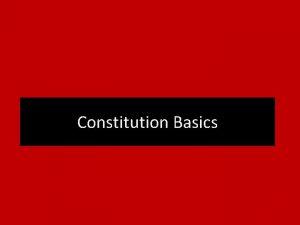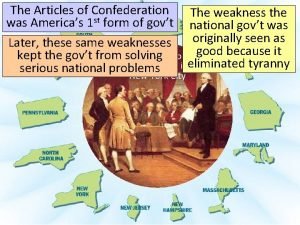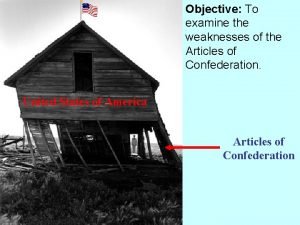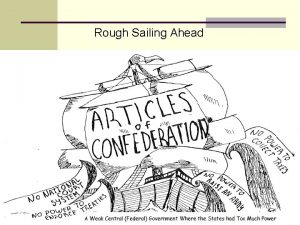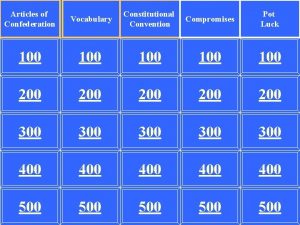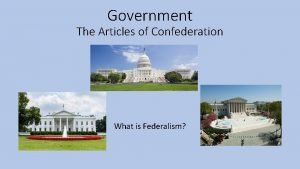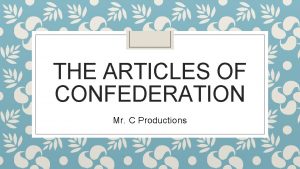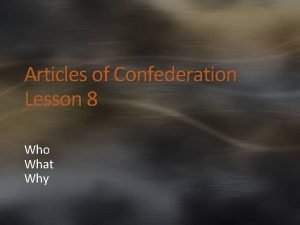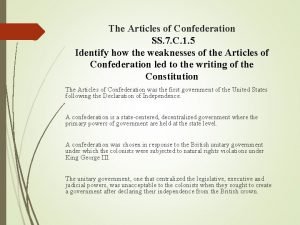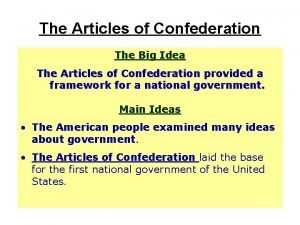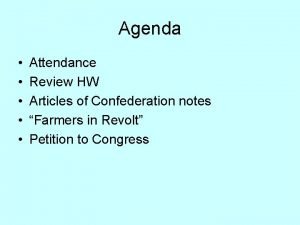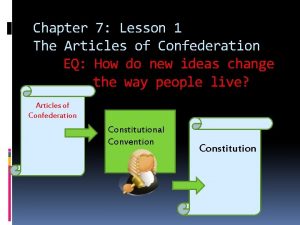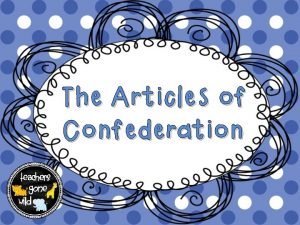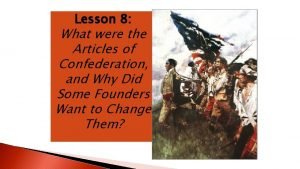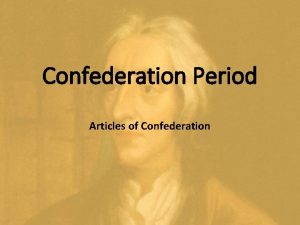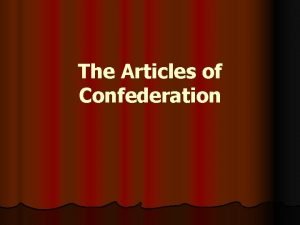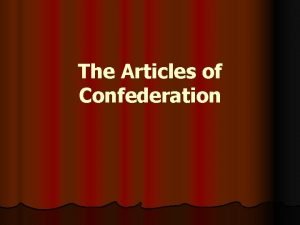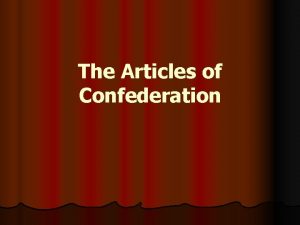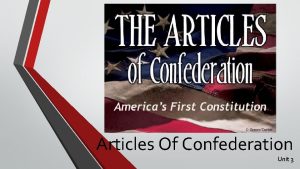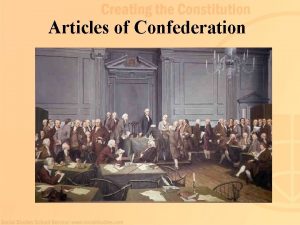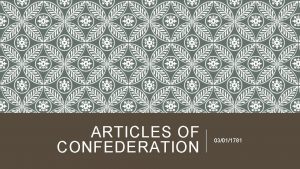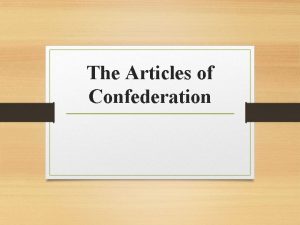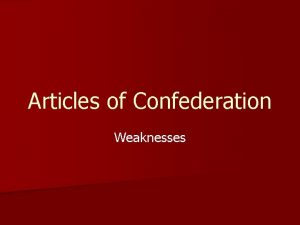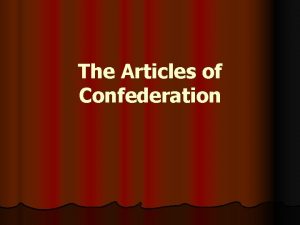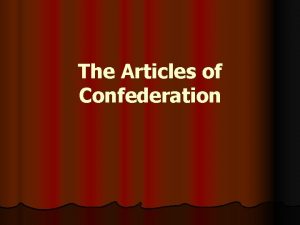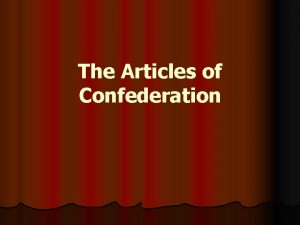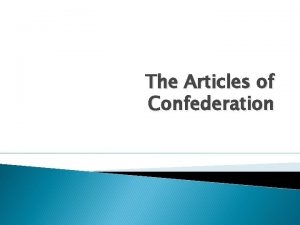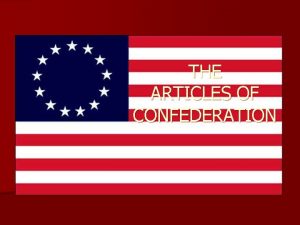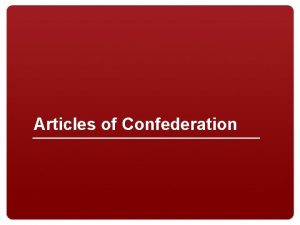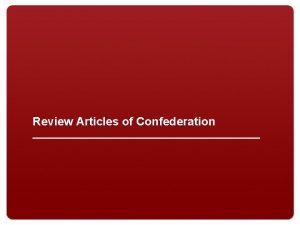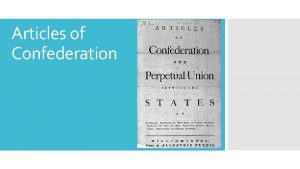The Articles of Confederation V A More Perfect


















- Slides: 18

The Articles of Confederation V. A More Perfect Union: The Constitution A. The Articles of Confederation 1. The first form of government in the United States of America 2. The Articles created a Congress representing each state equally. 3. The states did not want the Federal government to have strong powers. 4. The Congress did have power to declare war and peace, create an army and navy, and borrow money.

The Articles of Confederation V. A. The Articles of Confederation 5. Congress could not elect a president, levy taxes on states, or enforce a law in a state that did not accept that law. 6. By the end of the war Congress was going broke. 7. The Continental currency (money) was worthless because of inflation. 8. This led to the country’s first depression.

Homework • Write a summary of your notes explaining why the Articles of Confederation were weak and needed to be replaced.

Strengths & Weaknesses of The Articles of Confederation Strengths Ø The states don’t lose their rights. Ø Can declare war & peace. Ø Each state has equal representation. Ø Could create an army and navy. Ø Congress could borrow money. Weaknesses • Couldn’t elect a president. • They could not levy taxes and went broke. • States could decide not to obey a law. • The currency became worthless and led to a depression.

Constitutional Convention V. B. The Constitutional Convention 1. The weak Articles of Confederation, Shay’s Rebellion and the depression caused the founders to create a Constitution. 2. 55 delegates meet in Philadelphia in 1787 to create a more perfect union. 3. James Madison, “the Father of the Constitution” creates the Virginia Plan. 4. The Virginia plan has a two-house legislature determined by population.

Representation • “Big states” those with large populations believed that representation should be by population. Ex. NY, VA, PA & MA • “Small States” believed all states should get equal votes. Ex. NJ, RI, DE • How should we fix this?

Constitutional Convention V. B. The Constitutional Convention 5. The New Jersey Plan calls for one house and one vote per state. 6. “The Great Compromise” creates two houses, an upper house with 2 Senators per state, and a House of Representatives determined by population. 7. The 3/5 th Compromise counts 5 slaves as 3 people for taxation and representation in Congress.

Article I of the Constitution V. C. Article I: The Legislature 1. Two houses of the Congress. a) The House of Representatives i) Each state represented proportionally (by population, ex. CA 53, WY 1). ii) Members serve for 2 years at a time and must be 25 years old. iii) The House sets the budget & taxes. b) The United States Senate i) Each state has two Senators. ii) Senators serve for 6 years and must be 30 years old. iii) The Senate approves treaties & appointments from the President.

Article I of the Constitution V. C. Article I: The Legislature 2. A bill becomes a law only by passing both houses of Congress with a majority vote. It then must be signed by the President. 3. The President can check Congress by vetoing the bill. 4. Congress can override the veto by a 2/3 vote.

Article II of the Constitution V. D. Article II: The Executive Branch 1. The President and Vice-President serve 4 year terms. 2. The President is elected by the Electoral College (more on this later!). 3. The President can veto bills or sign them into law. 4. The President appoints cabinet members, ambassadors, judges & other members of government. 5. The President is the Commander in Chief of the Armed forces & can issue Executive Orders in an emergency.

Article III of the Constitution V. E. Article III: Judicial Branch 1. The Judicial power resides in the Supreme Court. 2. 9 Supreme Court judges are appointed for life terms. 3. The Supreme Court rules on appeals cases & whether laws are Constitutional or not. 4. The Supreme Court sets precedent for future cases.

Checks & Balances V. F. Checks and Balances 1. The Constitution was created with a system of checks and balances to prevent one branch of government from becoming too powerful. 2. The President checks Congress by vetoing bills and the Supreme Court by appointing justices. 3. Congress checks the President by overriding vetoes (with a 2/3 vote) & by approving nominations. 4. The Supreme Court checks Congress & the President by ruling on whether laws are Constitutional or not.

The Bill of Rights V. G. The Bill of Rights 1. The first 10 amendments to the Constitution are called the Bill of Rights. 2. They protect the civil liberties of individuals of the United States. Amendment I: Protects the freedom of religion, speech, & the right to protest. Amendment II: Protects the right to keep a militia & for people to “bear” arms. This is frequently debated by those in favor or against gun control.

The Bill of Rights V. G. The Bill of Rights Amendment III: The army cannot quarter troops without consent. Amendment IV: Citizens cannot have their property searched or seized without probable cause. Amendment V-VIII: Protects rights to a fair, speedy, jury trial without excessive bail. Amendment IX-X: All other powers not given by the Constitution are given to the states.

How to Amend the Constitution V. H. Amending the Constitution 1. Amongst thousands of ideas for changes only 27 Amendments have passed. 2. To Amend the Constitution: a). Receive a vote of 2/3 or more in both houses of Congress. b). Pass 3/4 of all state legislatures.

Other Amendments to the Constitution V. I. Beyond the Bill of Rights a) The 12 th Amendment corrects the problem of electing a President & V. P. b) The 13 th-15 th Amendments deal with the abolition of slavery after the Civil War. c) The 16 th Amendment allows Congress to collect income taxes. d) The 18 th Amendment, called Prohibition, outlawed alcohol but was repealed by the 21 st Amendment. e) The 19 th Amendment (1920) guaranteed women the right to vote.

Other Amendments to the Constitution V. I. Beyond the Bill of Rights f) The 22 nd Amendment limits presidents to two elected terms. g) The 26 th Amendment guarantees the right to vote to all citizens 18 or older. h) Many other amendments, (such as the Equal Rights Amendment, ) have failed because the Constitution is difficult to change. Should our school have its own Constitution?

Unit 5 Test Essay Questions Choose Two! • Explain the concept of checks and balances and how we avoid one branch from becoming too powerful. • What are three branches of government? Explain each branch’s responsibilities and why we need each one. • Determine what the Bill of Rights are & why they are important (be sure to explain the rights guaranteed by them).
 Lirik lagu more more more we praise you
Lirik lagu more more more we praise you More more more i want more more more more we praise you
More more more i want more more more more we praise you Weaknesses of articles of confederation
Weaknesses of articles of confederation Legislative branch
Legislative branch Failures of the articles of confederation
Failures of the articles of confederation What does rough sailing ahead mean
What does rough sailing ahead mean Articles of confederation vocabulary
Articles of confederation vocabulary Problems with the articles of confederation
Problems with the articles of confederation Articles of confederation fail
Articles of confederation fail Articles of confederation
Articles of confederation Lesson 8 the articles of confederation
Lesson 8 the articles of confederation Weaknesses of the articles of confederation
Weaknesses of the articles of confederation 3 5ths compromise
3 5ths compromise Articles of confederation fail
Articles of confederation fail Articles of confederation activity
Articles of confederation activity Articles of confederation clipart
Articles of confederation clipart Problems of the articles of confederation
Problems of the articles of confederation Articles of confederation jeopardy
Articles of confederation jeopardy Articles of confederation apush
Articles of confederation apush


